Coolant Temperature Rising on First Trip Out
#1
Rennlist Member
Thread Starter
Join Date: Sep 2007
Location: Ridgecrest, California
Posts: 1,363
Likes: 0
Received 143 Likes
on
28 Posts
So after I took the engine out, disassembled, cleaned, reassambled and re-installed late this summer, I have been working just about every free moment on getting the rest of the mechanicals back to 100% (there are just too many things to list - but basically, anything that could be worn out - WAS worn out and was replaced). I finally got there 2 days before Christmas and decided to take the Shark down to Redlands for our annual trip to the family for Christmas (about 135 miles one-way). Other than test runs, this was the first road trip out since all the mechanical restoration was complete.
The trip down was fantastic! Sharkie performed beautifully! Even had the opportunity to pass several cars at one time (the highway is 2 lanes most of the way). My wife even exclaimed, "Oh My!" and I haven't heard those words from her for quite some time!
Even had the opportunity to pass several cars at one time (the highway is 2 lanes most of the way). My wife even exclaimed, "Oh My!" and I haven't heard those words from her for quite some time! 
So on the way home, 2 days later. It's kinda cool outside and we decide to use the heater. Heat comes out but the fan isn't working. Haven't used the heater in years...at least 8 maybe 10 year. About half way home, I notice the temperature guage climbing. It had always held between the first line and midway - regardless of outside temp. But now it had reached the top white line (before the RED). It never went over the 2nd white line the rest of the way home.
The only thing that changed from the trip down and the trip back was the use of the heater (for the first time). Since some of my pipes (heater "Y" pipe) were rusted when I took the engine out, I suspected the heater core may have been rusted as well and when we turned the heat on, it must have flushed the rust into the radiator (as possibly the engine block as well).
So, yesterday I drained the radiator and engine block to see what I could find. Here's a picture of what came out of the radiator...
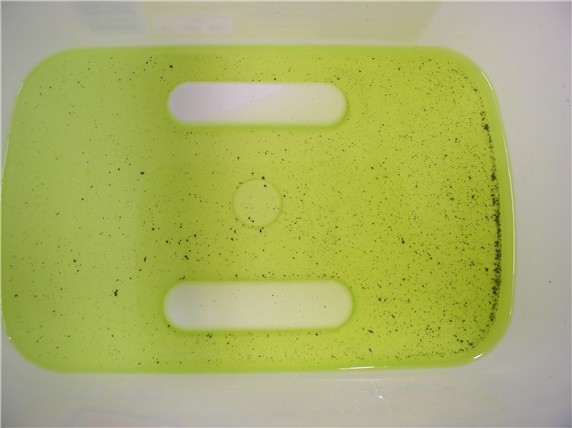
This did not look normal. I replaced the radiator about 9 years ago so I didn't suspect this was coming from the radiator. However, the car has sat in storage most of the last 8 years. So drained the block of coolant and this is what came out:
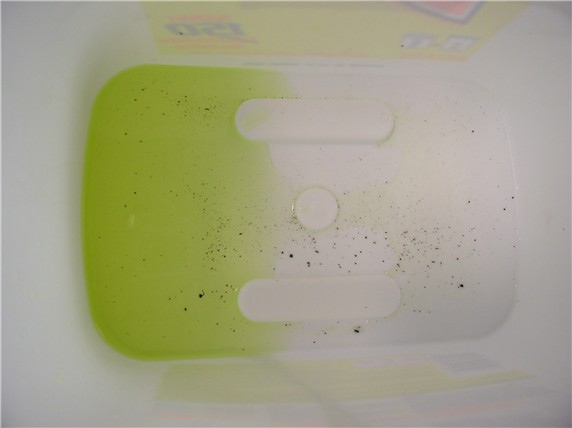
At this point, I decided to take the radiator out of the car and flush it with a hose. Took it out, laid it flat, filled it up and dumped the water into the bucket to see what might come out. And even more came out....
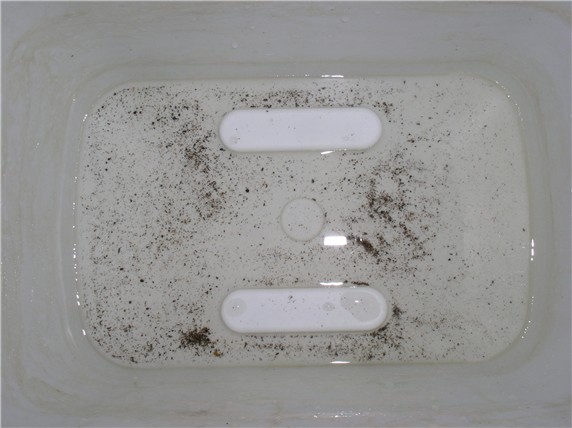
So I set the radiator on end and did a continuous flush:
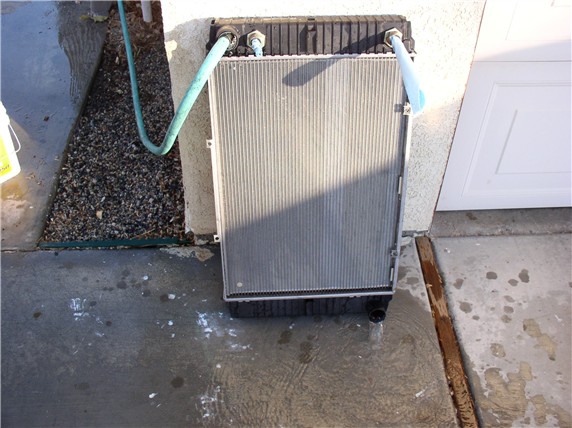
I did this until I got clear water (in the bucket). Here's one of the flakes that washed out:
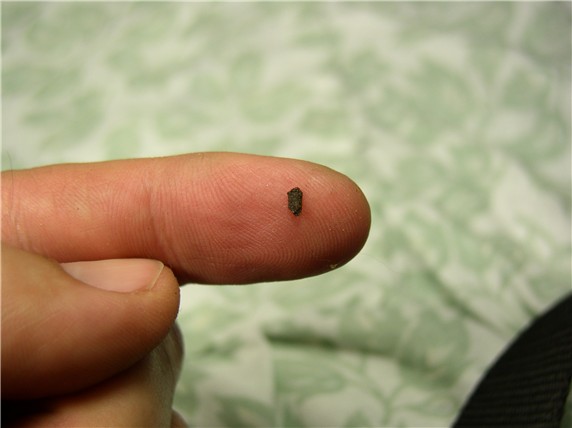
I'm not sure where all this came from but to be safe, I decided to cap off the heater intake and return hoses at the firewall. Then I filled the car up with 4 gallons of distilled water and ran it to temperature. Got the same temperature readings as before (2nd white line before the red). I drained the all the water out. This time only 2 or 3 specks showed up in the bucket. So I filled it back up with 50/50 anti freeze and distilled water. Took it for more highway test driving today and same high temp.
At this point, I'm contemplating replacing the radiator. Is there a high capacity, heavy duty radiator available?? Opinions welcome!
The trip down was fantastic! Sharkie performed beautifully!
 Even had the opportunity to pass several cars at one time (the highway is 2 lanes most of the way). My wife even exclaimed, "Oh My!" and I haven't heard those words from her for quite some time!
Even had the opportunity to pass several cars at one time (the highway is 2 lanes most of the way). My wife even exclaimed, "Oh My!" and I haven't heard those words from her for quite some time! 
So on the way home, 2 days later. It's kinda cool outside and we decide to use the heater. Heat comes out but the fan isn't working. Haven't used the heater in years...at least 8 maybe 10 year. About half way home, I notice the temperature guage climbing. It had always held between the first line and midway - regardless of outside temp. But now it had reached the top white line (before the RED). It never went over the 2nd white line the rest of the way home.
The only thing that changed from the trip down and the trip back was the use of the heater (for the first time). Since some of my pipes (heater "Y" pipe) were rusted when I took the engine out, I suspected the heater core may have been rusted as well and when we turned the heat on, it must have flushed the rust into the radiator (as possibly the engine block as well).
So, yesterday I drained the radiator and engine block to see what I could find. Here's a picture of what came out of the radiator...

This did not look normal. I replaced the radiator about 9 years ago so I didn't suspect this was coming from the radiator. However, the car has sat in storage most of the last 8 years. So drained the block of coolant and this is what came out:

At this point, I decided to take the radiator out of the car and flush it with a hose. Took it out, laid it flat, filled it up and dumped the water into the bucket to see what might come out. And even more came out....

So I set the radiator on end and did a continuous flush:

I did this until I got clear water (in the bucket). Here's one of the flakes that washed out:

I'm not sure where all this came from but to be safe, I decided to cap off the heater intake and return hoses at the firewall. Then I filled the car up with 4 gallons of distilled water and ran it to temperature. Got the same temperature readings as before (2nd white line before the red). I drained the all the water out. This time only 2 or 3 specks showed up in the bucket. So I filled it back up with 50/50 anti freeze and distilled water. Took it for more highway test driving today and same high temp.
At this point, I'm contemplating replacing the radiator. Is there a high capacity, heavy duty radiator available?? Opinions welcome!
#2
Team Owner
you might want to replace the thermostate first. Check the temperature sender as well
if you put a new one in and it still runs warm then you will have a spare , also check the rear side of the thermostate after its removed there migt be a rubber seal that is pressed into the housing this usually rusts out and can be replaces .
The rust your finding looks like its coming from the metal portions of the heater lines, the heater itself is made of metal that wont rust. With the heater connected to the cooling system to purge the air out of the system you need to open the heater control and drive the car for about 5 miles then top the cooling system off
if you put a new one in and it still runs warm then you will have a spare , also check the rear side of the thermostate after its removed there migt be a rubber seal that is pressed into the housing this usually rusts out and can be replaces .
The rust your finding looks like its coming from the metal portions of the heater lines, the heater itself is made of metal that wont rust. With the heater connected to the cooling system to purge the air out of the system you need to open the heater control and drive the car for about 5 miles then top the cooling system off
#3
Rennlist Member
Thread Starter
Join Date: Sep 2007
Location: Ridgecrest, California
Posts: 1,363
Likes: 0
Received 143 Likes
on
28 Posts
you might want to replace the thermostate first. Check the temperature sender as well
if you put a new one in and it still runs warm then you will have a spare , also check the rear side of the thermostate after its removed there migt be a rubber seal that is pressed into the housing this usually rusts out and can be replaces .
The rust your finding looks like its coming from the metal portions of the heater lines, the heater itself is made of metal that wont rust. With the heater connected to the cooling system to purge the air out of the system you need to open the heater control and drive the car for about 5 miles then top the cooling system off
if you put a new one in and it still runs warm then you will have a spare , also check the rear side of the thermostate after its removed there migt be a rubber seal that is pressed into the housing this usually rusts out and can be replaces .
The rust your finding looks like its coming from the metal portions of the heater lines, the heater itself is made of metal that wont rust. With the heater connected to the cooling system to purge the air out of the system you need to open the heater control and drive the car for about 5 miles then top the cooling system off
I had not considered the temperature sending unit! These are a lot cheaper than a new radiator and I am still using my old one. This might be a worthwhile try first.
I replaced the "Y" pipe and the metal pipe close to the heater control valve when I had the engine out. So these shouldn't be the source. So there is nothing from the hose connections at the firewall into the heater piping inside the cabin that could rust?? If this is the case, I may as well re-connect the heater hoses since that's not the source of the rust. That would leave only one possibility....the radiator. Right?
Just seems strange this happened only after we used the heater.....
#4
Rennlist Member
Are your fans working properly ? Is the lower part of the rad cooler than the top ? When you warm it up can you feel the the temp of hose get hotter as tstat opens ? Can you pick up flakes with a magnet ?
#5
Rennlist Member
Thread Starter
Join Date: Sep 2007
Location: Ridgecrest, California
Posts: 1,363
Likes: 0
Received 143 Likes
on
28 Posts
Hello Zeus,
Great questions. Yes the fans are both working. The electric comes on as the temp nears the upper white line on the guage. I haven't felt the hoses as the car warms up so I can try that next. Unfortunately, I washed all the flakes out and don't have any more to try the magnet test - but good thinking - wish I would have thought of that before.
Great questions. Yes the fans are both working. The electric comes on as the temp nears the upper white line on the guage. I haven't felt the hoses as the car warms up so I can try that next. Unfortunately, I washed all the flakes out and don't have any more to try the magnet test - but good thinking - wish I would have thought of that before.
Trending Topics
#8
Rennlist Member
Dwayne, just to be sure on the thermostat...
new thermostat, new o-ring and new in-block sealing ring, right? 3 pieces to this job, not 2.
When t-stat opens, it also closes against that sealing ring, which is rubber afixed to ferrous metal ring. Odd arrangement but crucial. The particles pictured remind me of the remnants of the ferrous core of that ring.
new thermostat, new o-ring and new in-block sealing ring, right? 3 pieces to this job, not 2.
When t-stat opens, it also closes against that sealing ring, which is rubber afixed to ferrous metal ring. Odd arrangement but crucial. The particles pictured remind me of the remnants of the ferrous core of that ring.
#9
Rennlist Member
The flushing may as well include removal of the block drains ... and then stuff the garden hose sealed with a rag into the T-stat opening. Another variation is to start the engine with max flow on the hose in the T-stat hole .... the water pump will help the effort: there is no risk of overheating doing this for a few min. Follow by a final flush of the rad.
#10
Under the Lift
Lifetime Rennlist
Member
Lifetime Rennlist
Member
So, I guess we're all thinking this crap came from an unused heater core. Seems likely. Still, it strikes me as a bit odd because the heater valve opens when the car is shut off and there is flow each time the car starts for at least a few seconds until the vacuum builds and the valve recloses. Some people have taken to modifying the valve so it is not open when the car stops, which could make this corrosion even worse if the heater goes unused.
Also, you'd think if the coolant were changed properly every 2 years, including the heater core, as it should be, this would not happen.
You didn't get much crap out by the looks of what you recovered from the drain and flush. There's probably a load more in there jammed in the tubes. Just filling it up and draining via gravity is not good enough. Unless you can build up some pressure in the reverse flow direction, not much is going to happen. It may need a side tank removed and a rodding. And the heater core probably needs much more thorough reverse direction flushing. Hope it doesn't spring a leak.
Also, you'd think if the coolant were changed properly every 2 years, including the heater core, as it should be, this would not happen.
You didn't get much crap out by the looks of what you recovered from the drain and flush. There's probably a load more in there jammed in the tubes. Just filling it up and draining via gravity is not good enough. Unless you can build up some pressure in the reverse flow direction, not much is going to happen. It may need a side tank removed and a rodding. And the heater core probably needs much more thorough reverse direction flushing. Hope it doesn't spring a leak.
#11
Rennlist Member
Thread Starter
Join Date: Sep 2007
Location: Ridgecrest, California
Posts: 1,363
Likes: 0
Received 143 Likes
on
28 Posts
Dwayne, just to be sure on the thermostat...
new thermostat, new o-ring and new in-block sealing ring, right? 3 pieces to this job, not 2.
When t-stat opens, it also closes against that sealing ring, which is rubber afixed to ferrous metal ring. Odd arrangement but crucial. The particles pictured remind me of the remnants of the ferrous core of that ring.
new thermostat, new o-ring and new in-block sealing ring, right? 3 pieces to this job, not 2.
When t-stat opens, it also closes against that sealing ring, which is rubber afixed to ferrous metal ring. Odd arrangement but crucial. The particles pictured remind me of the remnants of the ferrous core of that ring.
Thanks for the question. I do not recall seeing a sealing ring. Only 2 pieces - the thermostat and the o-ring. Does the rubberized sealing ring attach to the thermostat or the housing?
I decided to check PET for the part and found it (928.106.163.00) but PET lists engine model number M28.21/22 and M28.11 M28.12. I'm not sure what this is telling me but my engine is M28/20 81E 07351. So I'm wondering if mine is supposed to have the sealing ring or not?? If it is supposed to have one, what function does it perform?? If it's missing or rusted, would it cause higher temps?? I think I'll try taking the thermostat out again tomorrow night and see if I can't find any traces of the sealing ring.
#12
Team Owner
the sealing ring if you have one is pressed into the rear of the Tstat housing if yours is bad it will be rusted and wavy rubber.
To remove it simply pry it from the side to the center and it should fall out install the new seal with a correctly sized socket and extension it just taps in.
If your housing looks like its machined for a seal in the Tstat housing it might have been removed and never replaced, The seal is a little bigger in diameter than a quarter and its a bit less than half an inch hi.
This is going on the basis that your car has a seal in the first place. If it doesnt get a new Tstat and put it in, if you get the same results then you have a spare T stat.
To remove it simply pry it from the side to the center and it should fall out install the new seal with a correctly sized socket and extension it just taps in.
If your housing looks like its machined for a seal in the Tstat housing it might have been removed and never replaced, The seal is a little bigger in diameter than a quarter and its a bit less than half an inch hi.
This is going on the basis that your car has a seal in the first place. If it doesnt get a new Tstat and put it in, if you get the same results then you have a spare T stat.
#13
Rennlist Member
Thread Starter
Join Date: Sep 2007
Location: Ridgecrest, California
Posts: 1,363
Likes: 0
Received 143 Likes
on
28 Posts
the sealing ring if you have one is pressed into the rear of the Tstat housing if yours is bad it will be rusted and wavy rubber.
To remove it simply pry it from the side to the center and it should fall out install the new seal with a correctly sized socket and extension it just taps in.
If your housing looks like its machined for a seal in the Tstat housing it might have been removed and never replaced, The seal is a little bigger in diameter than a quarter and its a bit less than half an inch hi.
This is going on the basis that your car has a seal in the first place. If it doesnt get a new Tstat and put it in, if you get the same results then you have a spare T stat.
To remove it simply pry it from the side to the center and it should fall out install the new seal with a correctly sized socket and extension it just taps in.
If your housing looks like its machined for a seal in the Tstat housing it might have been removed and never replaced, The seal is a little bigger in diameter than a quarter and its a bit less than half an inch hi.
This is going on the basis that your car has a seal in the first place. If it doesnt get a new Tstat and put it in, if you get the same results then you have a spare T stat.
I'm going to try what you suggest: take out the thermostat, look for evidence of the seal and order both the seal and another thermostat (I'm using 180 degree thermostat now). I'll do this tomorrow and post what I find in the thermostat housing. In addition, I'll reconnect the heater hoses. I could see no evidence of rusted pipes from the firewall side and I flushed it with a funnel and distilled water - not much force from gravity, though. The water seemed to be clear coming out.
The following users liked this post:
bryske (07-12-2022)
#14
Rennlist Member
The seal in-question attaches to a waterway opening directly behind the thermostat.
Functionally, if it degrades, water that should be pumped to the radiator for cooling goes through the block instead. (The warm-up mode on the car)
If yours was old, then during your drive, unrelated to the usage of the heater, it could have degraded further and allowed a portion more water to bypass the radiator. So, maybe you had 75% passing the radiator and 25% bypassing....just speculation, but fairly probable. Easy to check.
Mine is running at first line when hot, for ref.
Functionally, if it degrades, water that should be pumped to the radiator for cooling goes through the block instead. (The warm-up mode on the car)
If yours was old, then during your drive, unrelated to the usage of the heater, it could have degraded further and allowed a portion more water to bypass the radiator. So, maybe you had 75% passing the radiator and 25% bypassing....just speculation, but fairly probable. Easy to check.
Mine is running at first line when hot, for ref.
#15
Under the Lift
Lifetime Rennlist
Member
Lifetime Rennlist
Member
If you did not replace that seal, then do it now. The old one will be very hard to see as it is pressed flat into the housing and usually corroded over. Once you lift the edge of it, you'll be able to to pry it out. I always replace it with the T-stat, although it is often overlooked and not part of the T-stat "kit". You have to ask for it specifically.
Here are some pictures (courtesy of George Suennen) that show one where the rubber coating is still identifiable. I've never seen one look this good coming out.
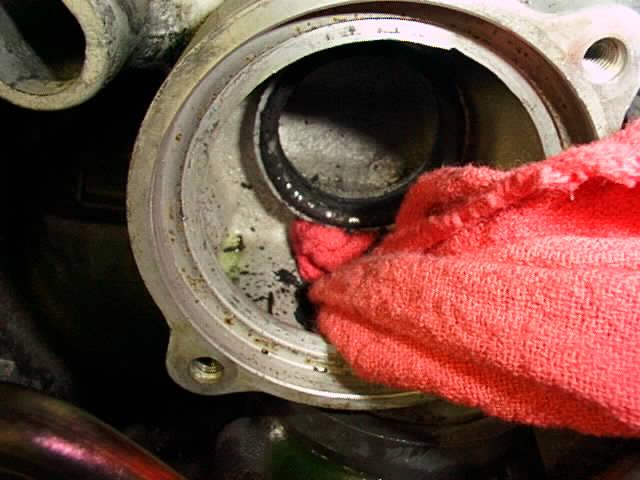


Here are some pictures (courtesy of George Suennen) that show one where the rubber coating is still identifiable. I've never seen one look this good coming out.




